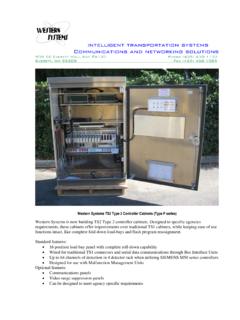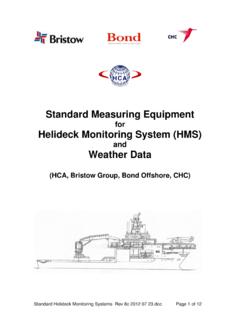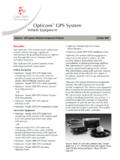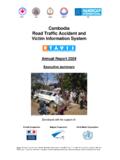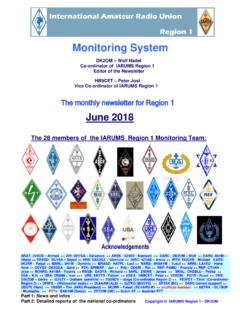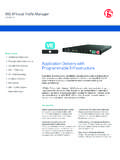Transcription of An Overview and Performance Evaluation of ACS Lite – A …
1 Shelby, Bullock, Gettman, Ghaman, Sabra, and Soyke An Overview and Performance Evaluation of ACS Lite A Low Cost Adaptive Signal Control system Steven G. Shelby, Siemens Energy & Automation, Inc. Business Unit Intelligent Transportation Systems 6375 E. Tanque Verde, Suite 170. Tucson, AZ 85715. Phone: (520) 290-8006 ext. 115. Fax: (520) 290-8178. Darcy M. Bullock, , Purdue University 550 Stadium Mall Dr West Lafayette, IN 47906. Phone: (765) 496-7314. Doug Gettman, Kimley-Horn & Associates 7878 N. 16th St., Suite 300. Phoenix, AZ 85020. Phone: (520) 977-5753. Raj S. Ghaman, FHWA Operations RD&T. 6300 Georgetown Pike McLean, VA 22101. Phone: (202) 493-3270. Ziad A. Sabra, , , PTOE. Sabra, Wang & Associates, Inc. 1504 Joh Avenue, Suite 160. Baltimore, MD 21227. Nils Soyke Siemens AG - ITS Division Sopers Lane Poole, Dorset, BH17 7ER. UK. Tel: +49 151 17446641. 1. Shelby, Bullock, Gettman, Ghaman, Sabra, and Soyke Submitted to the 87th TRB Annual Meeting in Washington, DC, January 2008.
2 Word count: 5,226. Figures: 4. Tables: 1. Total Equivalent: 6,476. ABSTRACT. FHWA recently developed Adaptive Control Software Lite, or ACS Lite, with the goal of providing a widely deployable system that automates monitoring of traffic signal Performance and adjustment of signal timing. The Lite designation reflects a focus on reducing traditionally high installation and operations costs, which have been the primary impediment limiting the deployment of adaptive systems in the The system has been integrated and tested with the CORSIM simulation and with signal controllers from four major manufacturers. This paper provides an Overview of the ACS Lite system and the results of independent Performance evaluations. Simulation Evaluation has demonstrated significant benefits in the context of suboptimal settings, and no harm done in the context of signal timing that was optimized with perfect knowledge of the traffic conditions.
3 Field evaluations were then conducted in four cites, with Eagle, Econolite, McCain, and Peek controllers respectively. In comparison with prior field settings, signal timing adjustments by ACS Lite provided substantial reductions in vehicle delay, arterial travel time, vehicle stops, and fuel consumption. The corresponding economic benefits of improved traffic flow were estimated to surpass system deployment costs within the first year. 2. Shelby, Bullock, Gettman, Ghaman, Sabra, and Soyke INTRODUCTION. The Federal Highway Administration (FHWA) initiated development of Adaptive Control Software Lite, or ACS Lite, to provide a widely deployable system that automates monitoring of traffic signal Performance and adjustment of signal timing (1). The Lite designation reflects a focus on reducing traditionally high installation and operations costs, which have been the primary impediment limiting the deployment of adaptive systems in the (2, 3).
4 A series of Performance evaluations of the initial ACS Lite research prototype were recently completed, in April 2007. This paper summarizes the project, the resulting system , and the Evaluation findings from simulation experiments and four field studies. BACKGROUND. Growing traffic delays are now ranked as the first or second largest community problem by citizens surveyed across the nation (4, 5). Suboptimal signal timing is one contributing factor, attributed with causing an estimated billion person-hours of vehicle delay annually in the United States a share representing as much as 13% of all traffic delay (6). The state of affairs is poignantly illustrated by Figure 1, the National traffic Signal Report Card, which assesses overall traffic signal operations in the with a grade of D- (7). Figure 1. National traffic Signal Report Card (source: NTOC, 2005). Off-line signal-timing optimization software, such as Synchro (8), is available to facilitate the task of updating signal timing; and, studies show that the economic benefits of well-timed signals outweigh the costs of retiming by a ratio of 40:1 or more (7).
5 However, the report card indicates that timing updates occur with unsatisfactory frequency in actual practice (7). 3. Shelby, Bullock, Gettman, Ghaman, Sabra, and Soyke The National Transportation Operations Coalition (NTOC) generated this report card based on questionnaires collected from 378 agencies across the nation, providing a self-assessment of their signal operations (7). NTOC analysis concludes that agencies are primarily challenged by limited resources characterized as a scarcity of funding and staffing (7). In this environment, daily management has degenerated to fighting fires , where the provision of basic traffic control functionality overshadows the provision of efficient operations. This effect is especially pronounced in smaller cities, where traffic signals represent only a small fraction of a city engineer's responsibilities. Nationally, it is estimated that 75% of signals are in need of retiming (6).
6 These findings suggest the need for on-line tools to automate the retiming of signals. While it is widely recognized that no single treatment will be the panacea for all traffic delays, adaptive signal timing does have a cross-cutting capability that extends beyond the 13% share of delay attributed to poor signal timing. Adaptive control can automatically reallocate capacity and resynchronize progression for unexpected ( , non-recurring) traffic conditions as they occur, flexing the system to accommodate traffic diverting from work zones, crashes, breakdowns, special events, and weather (such as snowed-in, iced-over, or flooded roadway segments). Intelligent transportation systems such adaptive traffic control have been recognized as a vital ingredient in plans to address the transportation needs of the nation (9, 10). However, agencies in the have historically been reluctant to adopt adaptive control.
7 Currently, there are approximately 28 adaptive system deployments in the , not including the ACS Lite field sites (11). In 1999, only 8 agencies reported using adaptive control a level of deployment that prompted the conception of the ACS Lite project (12). A survey of agencies by FHWA has elucidated some of the underlying sources of reluctance (3). Furthermore, feedback has been solicited from practitioners at an international conference, who were invited for a roundtable discussion of adaptive control (2). The feedback from these efforts has provided the following list of concerns that have limited the adoption of adaptive control systems. High cost (cited by 70% of responding agencies). system complexity. Uncertain benefits (cited by 40% of responding agencies). Sensitivity to detection. Sensitivity to communications. The objectives of the ACS Lite project formulated by FHWA implicitly required directly addressing the concerns listed above.
8 The ACS Lite goals and requirements can be summarized as follows: Build a cost-effective, widely deployable adaptive control system . Focus on linear, arterial networks. Integrate with the CORSIM simulation model. Target closed-loop system applications, capable of operating without any central facility. Utilize the NTCIP communications protocol, without per-second communications. Integrate and field test with all participating NEMA vendors. 4. Shelby, Bullock, Gettman, Ghaman, Sabra, and Soyke The research and development of ACS Lite has been carried out by Siemens, with collaboration and testing support from Purdue University, The University of Arizona, and ITT Industries. FHWA invited signal controller manufacturers that are members from the National Electronical Manufacturers Association (NEMA) to participate in and support the project. The invitation was accepted by Eagle (Siemens), Econolite, McCain, and Peek (Quixote).
9 The project began in 2002, and the last of four field evaluations was completed in 2007. system DESCRIPTION. ACS Lite could be briefly summarized as an adaptive closed-loop system . Figure 2a illustrates a typical closed-loop system architecture, where a supervisory computer monitors and coordinates the timing of several signal controllers. This section summarizes the system architecture of ACS. Lite, describing the roles and requirements of the system components namely, the local . intersection controllers, their vehicle detectors, and communications. Architecture Options The specific configuration of closed-loop systems may vary from one deployment to the next, and ACS Lite is flexible in this regard. This is exemplified in figure 2, which illustrates the system architectures deployed for field tests with each of the four participating manufacturers. Figures 2a and 2d illustrate that ACS Lite may serve as a replacement for a legacy field master, providing standard features such as clock synchronization and command of patterns according to a time-of-day (TOD) schedule.
10 Conversely, ACS Lite has also been operated in tandem with existing field masters, as shown in figures 2b and 2c, where the existing master maintained pattern control. Furthermore, the ACS Lite software may optionally be hosted on a server at a traffic management center (TMC), as shown in figure 2c; or, the software may run on a field- hardened processor, deployed in the equipment cabinet at one of the arterial intersections. 5. Shelby, Bullock, Gettman, Ghaman, Sabra, and Soyke ACS Lite NTCIP protocol Local Controllers (a). ACS Lite ASC/2M Field Master (b) NTCIP protocol Econolite protocol (solid lines). ACS Lite 2070 Field Master NTCIP protocol (c). BI Tran protocol ACS Lite NTCIP Translators NTCIP protocol (d) Peek protocol Local Controllers Figure 2. system architectures used with (a) Eagle, (b) Econolite, (c) McCain, and (d) Peek. Signal Network Layout FHWA targeted an arterial network as a relatively simplistic initial scope for ACS Lite deployment.
